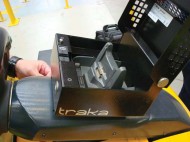 John Kent, Chairman of Traka plc, has been leading the Traka team which has been working with Tesco over the years to transform the way the retailer uses fork trucks in its distribution centres to make them safer places to work.
John Kent, Chairman of Traka plc, has been leading the Traka team which has been working with Tesco over the years to transform the way the retailer uses fork trucks in its distribution centres to make them safer places to work.
“Tesco is the world’s second largest retailer,” says John Kent, “because they have a great business, led by a great team of people and, whilst they may be chasing margins and profits for their shareholders, they also run a responsible business.”
A key part of Tesco’s success is its efficient distribution of goods to stores. This is an immensely complex operation involving the use of a wide range of technology including mechanical handling equipment to move the palletised loads and the cages containing the picked product.
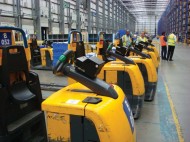 Like the majority of DC’s, Tesco use reach trucks for moving pallets and low level order pickers for transporting cages. Mechanical handling equipment is notorious for high levels of running costs often caused by damage with drivers rushing to complete their next pick. This is the problem Traka has been helping address.
Like the majority of DC’s, Tesco use reach trucks for moving pallets and low level order pickers for transporting cages. Mechanical handling equipment is notorious for high levels of running costs often caused by damage with drivers rushing to complete their next pick. This is the problem Traka has been helping address.
“It’s not just the truck that gets damaged but also the building infrastructure and especially the racking, sometimes with expensive consequences. Fork trucks are dangerous machines when used irresponsibly and can cause serious injury. Every organisation needs to take the management of safeguarding their staff very seriously: Tesco’s certainly do,” says John Kent.
“We started working with Tesco some ten years ago. At that time they used a simple key activated starter switch that was then common on fork trucks. The usual practice was to have a yellow key for picking trucks and a red key for reach trucks. These would be handed to drivers at the start of each shift in exchange for their clocking on cards.
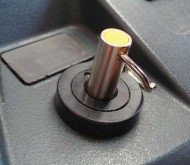 “However, with just two keys, it didn’t take long before the industry was knee deep in these keys and a driver could usually acquire an illegal key easily. And with common keys, there was no way of knowing who had driven which truck. So if a truck was damaged it was very difficult to identify the driver.”
“However, with just two keys, it didn’t take long before the industry was knee deep in these keys and a driver could usually acquire an illegal key easily. And with common keys, there was no way of knowing who had driven which truck. So if a truck was damaged it was very difficult to identify the driver.”
At this time, Traka were promoting their intelligent key management systems. These electronic cabinets held existing keys attached to a clever bullet shaped device, called an iFob. The iFob located into a port inside the cabinet, where it would be locked in place. For a user to take a key, he had to identify himself with his ID and the system would only release a key if his authority was valid for that key. So the Traka system could check to make sure that firstly he had a valid licence and secondly he had authority to take the required key. Only then would the key be released and an automatic audit created. Thus the user became responsible for the key (and what the key accessed) without the need for supervised key issue.
Traka is now used extensively around the world for managing keys for a huge range of organisations, from prisons to car dealers and from naval bases to royal households. Currently the police have some 350 systems, so the diversity and success of the product can be appreciated.
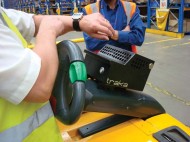 “The Traka system was a universal key management system when Tesco were looking at using it on their trucks,” says John Kent, “But for fork truck management more was needed and we quickly realised that the iFob could become a key in its own right, simply because each one is uniquely identified by an electronic chip inside. So we developed a reader for the iFob, known as the Datalogger Immobilisor. This is easily installed, connected to the trucks power supply and replaces the key switch on the truck dash. These were introduced in 2000 and since then have been developed and improved and are currently on some eight thousand trucks.”
“The Traka system was a universal key management system when Tesco were looking at using it on their trucks,” says John Kent, “But for fork truck management more was needed and we quickly realised that the iFob could become a key in its own right, simply because each one is uniquely identified by an electronic chip inside. So we developed a reader for the iFob, known as the Datalogger Immobilisor. This is easily installed, connected to the trucks power supply and replaces the key switch on the truck dash. These were introduced in 2000 and since then have been developed and improved and are currently on some eight thousand trucks.”
Next for development was the Traka Acceptance Button. Every driver is expected to check the truck at the start of each shift to ensure that it is safe and is trained to inspect everything from the brakes to the horn and lights. In an ideal world he would complete a written form, ticking off everything as tested and then hand it back to his supervisor for filing. Imagine how many forms would be accumulated over 12 months – 120 trucks on a three-shift operation would create 129,600 forms, any of which could be required for inspection by the HSE!
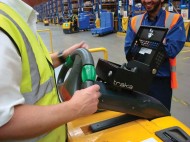 The Acceptance Button replaces the need for paperwork completely. All the driver has to do is insert the iFob into the barrel on the truck dash. This immediately starts a (configurable) timer, which gives sufficient time for the driver to check all the items. If happy with the inspection, he simply presses the Acceptance Button. This writes an electronic token to the iFob, which is retained until replaced into the Traka cabinet. This action then transfers the data to his computerised records. Now there is a clear permanent record that the driver accepted the truck condition. No more paperwork and records that last for years!
The Acceptance Button replaces the need for paperwork completely. All the driver has to do is insert the iFob into the barrel on the truck dash. This immediately starts a (configurable) timer, which gives sufficient time for the driver to check all the items. If happy with the inspection, he simply presses the Acceptance Button. This writes an electronic token to the iFob, which is retained until replaced into the Traka cabinet. This action then transfers the data to his computerised records. Now there is a clear permanent record that the driver accepted the truck condition. No more paperwork and records that last for years!
Should a driver find a problem however, he then simply reports it when prompted, upon returning the iFob. All he has to do is read from an adjacent printed list to find the code that corresponds to the problem and enters it on the Traka keypad. As the door closes this information is immediately relayed to the database where it can be seen by the engineer who can take the appropriate action.
What’s more, if the fault is dangerous; the iFob is locked in place with the truck VOR until fixed.
In 2008, Tesco introduced new shift change over practices and replacing iFobs into Traka cabinets, ready for the next driver was no longer viable and so Traka developed and implemented a new concept to suit this new method.
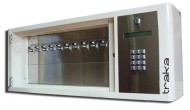 This new concept means that a driver now carries a permanent iFob as part of his personal issue. When arriving and waiting for his truck assignment he simply inserts the iFob into a Traka Download station. He swipes his card and immediately the iFob is charged with the truck types his licence validates him to drive. He now has a valid iFob which he can use on any allowed truck. As he starts the truck he has to complete the safety check as before and if accepted, the shift starts. At shift end he simply goes home but, significantly, the iFob will expire, so if the iFob is lost or passed to a colleague, it will no longer work. It will however still maintain records of the trucks driven, the times, the acceptances and even any faults logged. This information is instantly downloaded as part of the recharge activity when the iFob is inserted at the download station. If this data is collated across the DC’s, a daily audit of truck usage can be seen, allowing the opportunity for truck deployment to better suit demand.
This new concept means that a driver now carries a permanent iFob as part of his personal issue. When arriving and waiting for his truck assignment he simply inserts the iFob into a Traka Download station. He swipes his card and immediately the iFob is charged with the truck types his licence validates him to drive. He now has a valid iFob which he can use on any allowed truck. As he starts the truck he has to complete the safety check as before and if accepted, the shift starts. At shift end he simply goes home but, significantly, the iFob will expire, so if the iFob is lost or passed to a colleague, it will no longer work. It will however still maintain records of the trucks driven, the times, the acceptances and even any faults logged. This information is instantly downloaded as part of the recharge activity when the iFob is inserted at the download station. If this data is collated across the DC’s, a daily audit of truck usage can be seen, allowing the opportunity for truck deployment to better suit demand.
Shift changeovers now take just a few minutes, yet still with full management of the drivers to ensure they have valid licences, they only drive the trucks they are allowed and they complete their pre-operational safety checks.
Traka customers quote significant reductions in truck damage due to driver accountability. Knowing that a supervisor knows which truck you were driving ensures a further level of care and, not only is damage reduced but at the same time safety is inherently improved too.
Like every organisation, productivity is what really drives the DC and drivers are issued with mobile computer terminals to instruct the next pick. These arm mounted terminals have rechargeable batteries which typically don’t last the whole shift, requiring the driver to log off, visit a service hatch and be issued with a new, charged battery. In a large DC, this could take as much as 15 minutes.
Godfrey Anderson, MHE sales manager says; “Tesco are the first organisation to use the new Traka on-truck AMT charging box. This can only be accessed if the driver has a valid iFob. Inside is the docking/charger station powered directly from the truck battery. The docking station also includes a spare battery, which is continually charged. So when the driver’s AMT indicates low voltage, all he needs to do is to stop the truck, log off, swap the battery, log back on and continue his pick, perhaps taking no more than a minute.” Traka calculate that the return on investment to Tesco implementing these truck mounted chargers is just weeks as a result of the productivity improvement in saving several minutes per person, per shift, seven days a week, every week of the year.
John Kent: “Of course designing and installing fork truck management systems is far more than simply installing a replacement to a key switch! It requires working with the IT departments to install additional software, scheduling the implementation of new hardware and training the drivers and team leaders/supervisors who will be managing the new system. We have a whole team dedicated to this offering a full follow up and on-site support service plus of course a specialist telephone help desk.”
Alan Fleary, Traka’s Customer Account Manager, responsible for the rollout, comments: “Tesco have a great team of people under considerable pressure to perform, but they have embraced the system and do understand why safety is so important. The drive for productivity must not compromise the well being of the staff and Traka really does give them a safer environment, yet one that is focused on productivity too.”
Traka plc tel: 01234 712345 www.traka.com




Comments are closed.